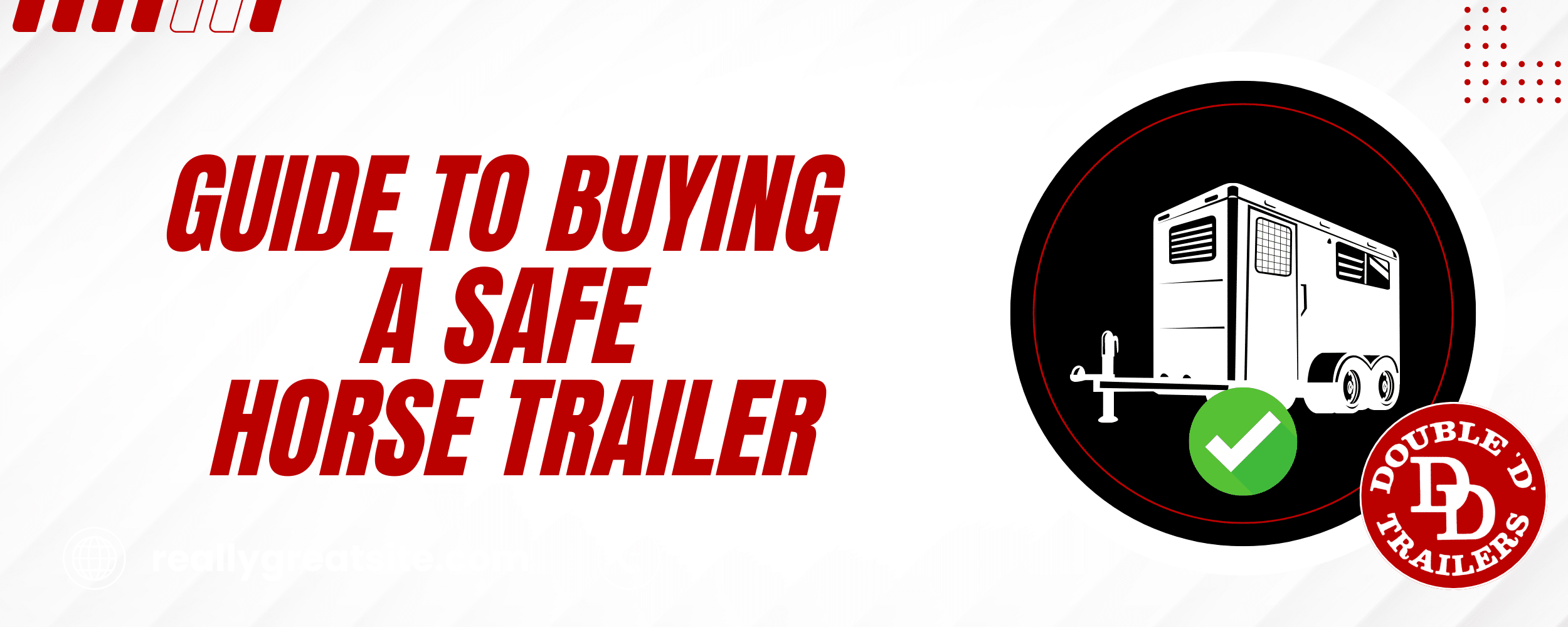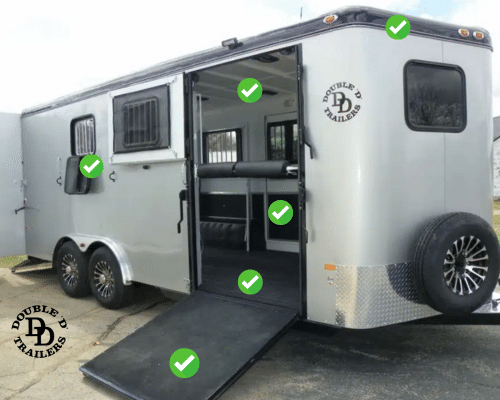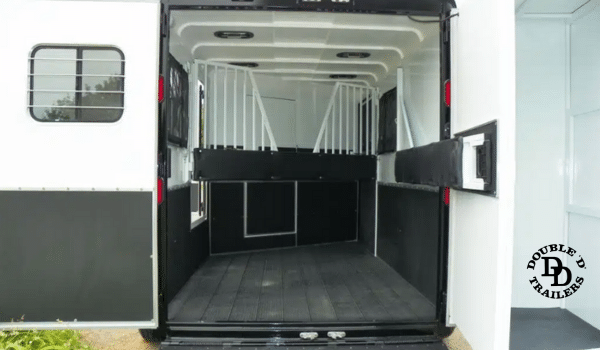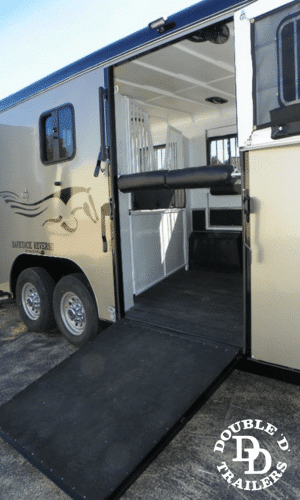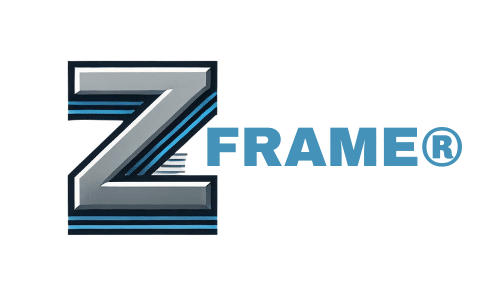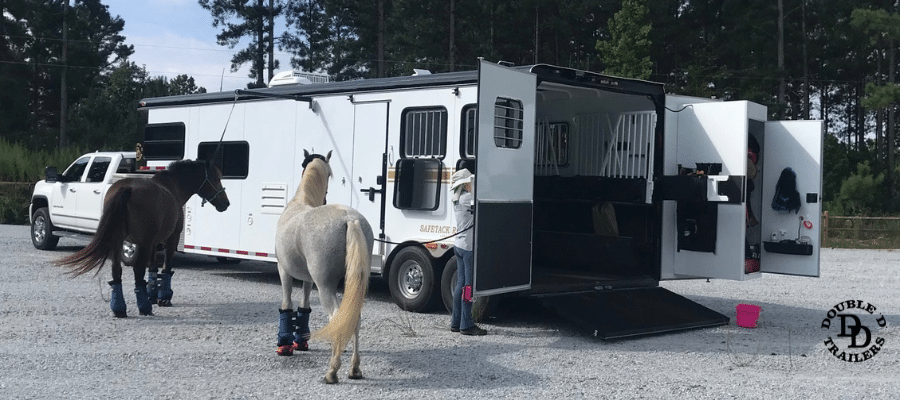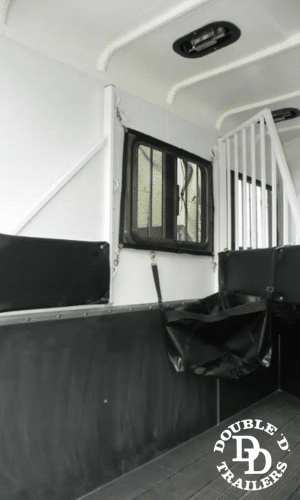Guide to Buying a Safe Horse Trailer
Transporting horses requires careful attention to safety and comfort, both for the horse and the handler. Whether you're transporting horses for competition, vet appointments, or long-haul journeys, the features of a safe horse trailer can make a significant difference in their well-being. This guide will help you make the best purchase decision by exploring key features of the safest horse trailers on the market.
What Makes a Horse Trailer Safe for Horses?
A safe horse trailer ensures horses' physical and psychological well-being during transport. Several critical factors contribute to this, from the structural design of the trailer to the materials used. Structural features like wide ramps, non-slip surfaces, and well-insulated walls are fundamental to preventing injury and reducing stress.
Horse trailers, designed with chemical bonding systems, such as the 3M VHB system, minimize road noise and vibration, which are the primary causes of stress during transport. This technology increases the structural flexibility of the trailer, which is crucial for long trips. In a podcast interview by Double D Trailers (Season 1, Episode 2) with Dr. Joren Whitley of Trinity Animal Chiropractic, Dr. Whitley cites the dangers of excess horse trailer vibration that can cause lasting damage to the horse’s spine and legs.
Proper ventilation also plays a significant role. Trailers with large windows and drop-down screens provide much-needed airflow, preventing the buildup of heat and ensuring a comfortable environment for the horse.
How Do Structural Features Improve Horse Trailer Safety?
Structural features that enhance safety include the following.
- Strong frame with flexibility for road shock absorption
- Well-insulated double-layered walls and floors
- Treated lumber flooring with a non-slip surface
- Wide, non-slip ramps with gentle slopes
- Well-lit and spacious loading area
A strong frame is essential for durability, but flexibility is equally important to absorb the shocks of the road. The Z-Frame Technology, which combines steel tubing with zinc and chromate coatings, offers an optimal balance between strength, flexibility, and corrosion resistance, outperforming traditional steel and aluminum frames. This combination not only ensures that the trailer is robust but also reduces the likelihood of structural fatigue over time, making it a long-lasting solution for horse owners.
Walls should be well-insulated to protect horses from extreme temperatures. Double-layered walls and floors reduce road noise and help maintain a cool environment inside the trailer, contributing to both safety and comfort during transport.
Flooring made from treated lumber with non-slip surfaces like Rumber is preferred over aluminum, as it provides better vibration absorption, traction, and longevity, which is crucial in preventing horses from slipping during loading, unloading, or transport.
The design of the loading area plays a critical role in horse trailer safety. A wide-open loading area is necessary because horses are naturally wary of tight, enclosed spaces. A narrow or poorly designed loading area can cause anxiety, making it difficult to load horses safely. Trailers with a wide, non-slip ramp ensure that horses can walk in with confidence, reducing the risk of falls or injuries. The angle of the ramp is also important—ramps that are too steep can cause horses to lose balance or hesitate to enter. Well-designed trailers feature ramps that are gently sloped, allowing for smooth entry and exit.
A well-lit loading areas help horses see better in low-light conditions, further reducing stress and increasing safety, especially during early morning or evening transportation.
In summary, a trailer's structural integrity, insulation, flooring, and loading area design are all critical components that work together to ensure the safety and comfort of horses during transport.
What Design Elements Reduce Stress and Anxiety in Horses During Transport?
Horses experience significant stress during transportation, often due to confined spaces, vibrations, and noise. To mitigate this, horse trailers should be designed with wide-open loading areas and spacious interiors. Horses are naturally claustrophobic, so a trailer with see-through tubular dividers helps alleviate their anxiety by allowing them to observe their surroundings.
Design elements such as well-lit entrances and padded dividers further reduce stress. Horses are more likely to load calmly in a trailer that feels open and safe. Dr. Claire Neveux's study on the effect of trailer lighting on horse behavior in a presentation during the 2018 French Equine Research Day in Paris highlights the importance of trailer brightness during loading.
How Does Insulation Contribute to the Safety of a Horse Trailer?
Insulation is a critical factor in regulating the temperature inside a horse trailer. Well-insulated walls and ceilings protect horses from heat in the summer and cold in the winter. A double-layered ceiling, preferably painted white, further helps maintain a cool temperature by reflecting sunlight. Additionally, insulated flooring contributes to overall comfort by reducing heat transfer and vibrations from the road.
Why Are See-Through Dividers Important in Horse Trailers?
See-through tubular dividers are essential for both horse comfort and safety. These dividers allow horses to maintain visual contact with their surroundings while being safely separated from each other. Tubular dividers prevent horses from feeling confined, which can otherwise lead to panic and injury. This open design also facilitates air circulation, improving ventilation throughout the trailer. These safety dividers are particularly important for nervous or young horses who may not be accustomed to travel.
What Are the Key Features of a Safe Horse Trailer?
These are the 3 key features of a safe horse trailer.
- Proper loading and unloading systems
- Quick-release mechanisms
- Emergency escape options
A safe horse trailer is designed to ensure ease of use while protecting horses from potential accidents.
How Does a Wide-Open Loading Area Ensure Safe Loading?
A wide-open loading area is essential for loading horses safely into a trailer. Horses are naturally hesitant to enter narrow spaces, so a trailer designed with ample loading space helps to avoid unnecessary stress or injury. Trailers should have wide ramps and well-lit entry points, ensuring visibility for both the handler and the horse.
Why Is a Non-Slip Ramp Essential for Safe Loading and Unloading?
Non-slip ramps are critical for preventing injuries during the loading and unloading process. Horses can easily lose their footing on smooth surfaces, especially in wet conditions. A non-slip surface made from rubber or textured materials provides the necessary traction, ensuring that horses maintain their footing as they enter or exit the trailer.
What Is the Role of Quick-Release Pins in Horse Trailer Safety?
Quick-release pins on butt and chest bars are essential for preventing horses from getting stuck or injured. Horses can sometimes rear or kick out, becoming caught on these bars. Quick-release pins ensure that the bars can be swiftly disengaged, even under the horse's weight, allowing for a safe and rapid escape.
Why Are Escape Doors Critical for Horse Trailer Safety?
Escape doors provide an additional exit for horses in the event of an emergency. Positioned on the side walls of the trailer, these doors offer a quick way to unload horses if the main exit becomes blocked. Emergency escape doors are particularly important in slant load trailers, where they can also serve as a secondary unloading route.
How Does Ventilation Affect the Safety of a Horse Trailer?
Proper ventilation is crucial for maintaining the health and comfort of horses during transport. Poor ventilation can lead to overheating, especially in hot climates, which can cause dehydration and heat stress. To ensure adequate airflow, trailers should feature large windows with drop-down screens that promote continuous air circulation.
What Are the Benefits of Large Windows with Drop-Down Screens?
Large windows with drop-down screens improve air circulation within the trailer, preventing the buildup of heat and stale air. The screens allow for ventilation while keeping debris and insects out, creating a safe and comfortable environment for the horse. Additionally, mid-latch systems make these windows easier to open and close during transit, ensuring safety and practicality.
How Does Proper Ventilation Prevent Overheating Inside a Trailer?
Proper ventilation prevents overheating by facilitating airflow and reducing the buildup of heat within the trailer. Increased airflow helps to dissipate the heat generated by the horses' bodies, as well as any ambient heat from the sun or road. The study “Air Exchange Rate in a Horse Trailer During Transport” conducted by Purswell, Gates, et. al. and published by the American Society of Agricultural and Biological Engineers demonstrated how horse trailers can become dangerously hot even with windows and vents open, highlighting the need for maximizing airflow and considering factors like trailer design and horse placement to ensure effective ventilation.
What Are the Best Materials for a Safe Horse Trailer?
These are the key materials for horse trailer durability.
- Z-Frame Technology (steel tubing with zinc and chromate coating)
- Treated lumber for flooring
- Rumber for non-slip surfaces
- Double-layered insulated walls and ceilings
The materials used in a horse trailer significantly impact its safety, durability, and comfort. Lightweight yet durable materials are preferred to ensure ease of towing while providing sufficient protection for the horses.
Why Is a Strong, Lightweight Frame Crucial for Horse Trailer Safety?
A strong, lightweight frame ensures both durability and towing efficiency. Traditional steel frames, though strong, are heavy and prone to rust. In contrast, Z-Frame Technology combines the strength of steel with lightweight zinc coatings, offering superior rust resistance and flexibility. This balance is essential for safe towing and long-term durability.
How Does Insulated Flooring Improve Safety and Comfort for Horses?
Insulated flooring reduces road vibration and noise, creating a more comfortable environment for horses. Insulation materials like treated lumber or composite flooring such as Rumber offer better durability and heat resistance compared to aluminum, which can weaken over time and transfer excessive heat into the trailer.
Why Is Treated Lumber a Safer Option for Horse Trailer Flooring?
Treated lumber is a safer option because it absorbs road vibrations and prevents heat transfer, unlike aluminum flooring. By providing both strength and shock absorption, treated lumber reduces the risk of injury during transport. On the other hand, aluminum floors can corrode and crack over time, creating a potential hazard for horses.
How Does Trailer Size and Weight Affect Safety?
Trailer size and weight affect the ease of towing and the safety of the horses during transport. A properly sized trailer reduces the risk of accidents and makes towing more manageable.
What Role Does Weight Distribution Play in Safe Horse Trailer Towing?
Weight distribution ensures that the trailer remains stable during transit, preventing accidents such as trailer sway. Trailers with poor weight distribution are more likely to cause accidents, especially when towed by vehicles that are not equipped to handle the load.
Using a horse trailer weight calculator helps determine the tongue weight ratio, but common practice recommends that the weight be evenly distributed between the front and rear axles, with 10% to 15% of the trailer's gross weight resting on the tongue.
How Do You Match a Safe Horse Trailer to Your Tow Vehicle?
Matching a horse trailer to your tow vehicle is essential to ensure safe transport. The tow vehicle must be capable of handling both the weight of the trailer and the horses inside. Always check the manufacturer's specifications for the vehicle and trailer to ensure compatibility.
What Is the Importance of Tongue Weight in Horse Trailer Safety?
Tongue weight is critical for balancing the load and preventing the trailer from tipping or swaying. A horse trailer should have a tongue weight that is 10% to 15% of its total weight, according to industry standards. This helps maintain control over the trailer and prevents dangerous situations on the road.
How Do Specific Horse Trailer Configurations Affect Safety?
The configuration of a horse trailer can significantly impact both safety and ease of use. A properly configured trailer reduces stress on the horse and makes loading and unloading easier.
Why Is the Reverse Load Configuration Considered the Safest?
The reverse load configuration is the safest for horses during transport. The study conducted by N.K. Waran, et. al. in the “Effects of transporting horses facing either forwards or backwards on their behavior and heart rate” and similar research by Sharon Cregier, show that “transporting horses while they are facing backward,180 degrees away from the direction of travel, induces less stress.”
If you're interested in exploring trailers with this configuration, learn more about the advantages of reverse load trailers.
How Does a Reverse Load Design Help Reduce Stress in Horses?
A reverse load design helps reduce stress by allowing horses to naturally position themselves to balance during transport. Horses instinctively brace with their hind legs, which are stronger than their forelegs, when facing backward, according to Dr. Cregier's research. This positioning minimizes the strain on their muscles and joints.
What Makes Reverse Load Trailers Easier for Unloading?
Reverse load trailers make unloading easier by allowing horses to step backward out of the trailer naturally. This eliminates the need for tight turns or backing out of narrow spaces, which can be stressful and dangerous for the horse.
What Materials and Parts Enhance Horse Trailer Safety?
Materials such as Z-Frame Technology, treated lumber flooring, and modern lighting solutions enhance horse trailer safety. Durable materials reduce the risk of damage, while well-designed parts improve the overall functionality and safety of the trailer.
To make an informed decision about trailer materials, read our guide on choosing proper materials for your horse trailer.
How Do Modern Lighting and Reflectors Improve Road Safety for Horse Trailers?
Modern lighting and reflectors enhance visibility, improving safety during nighttime or low-visibility conditions. LED lighting systems are particularly effective, as they are brighter, more durable, and consume less energy than traditional bulbs. Reflectors placed strategically on the trailer ensure that it remains visible to other drivers, reducing the risk of accidents.
Why Are Spring-Assisted Ramps Safer and More Convenient?
Spring-assisted ramps make it easier to load and unload horses by reducing the effort needed to operate the ramp. These ramps are safer because they prevent the handler from struggling with a heavy ramp, which could cause accidents.
How Does Z-Frame Technology Compare to Other Frame Options?
Z-Frame Technology offers superior durability and flexibility compared to traditional steel or aluminum frames. This innovation combines the best properties of steel and aluminum, providing strength without the weight penalty or corrosion issues associated with traditional materials.
What Are the Top 3 Safety Features to Look for Inside a Horse Trailer?
The 3 most important safety features inside a horse trailer include the following.
- Proper insulation
- Thick padding
- Tubular dividers.
These features are essential for ensuring the comfort and safety of horses during transport.
Why Are Thick Padding and See-Through Dividers Essential?
Thick padding and see-through dividers prevent injury and reduce stress by providing a cushioned and open environment for horses. Padded walls and partitions protect horses from injuries caused by contact with hard surfaces, while the dividers ensure that horses feel secure without feeling confined.
How Do Insulated Roofs and Sidewalls Protect Horses During Travel?
Insulated roofs and sidewalls maintain a stable temperature inside the trailer, protecting horses from extreme heat or cold. This insulation reduces the risk of heat stress and hypothermia, keeping the horse comfortable throughout the journey.
What Role Does Interior Lighting Play in Horse Trailer Safety?
Interior lighting is crucial for ensuring safe loading and unloading in low-light conditions. Well-placed lights inside the trailer reduce shadows and create a bright, inviting environment for the horse, making it easier to load and unload, especially at night. Consider using LED interior lighting for its brightness and energy efficiency.
Find the Right Safe Horse Trailer for Your Needs
Ensuring the safety and comfort of your horses during transport requires a trailer that combines thoughtful design with durable materials. Features such as wide, non-slip ramps, well-insulated walls, proper ventilation, and reverse load configurations all play a critical role in reducing stress and preventing injury. Additionally, technologies like Z-Frame construction and Rumber flooring enhance both the trailer's durability and towing stability.
Let's start with how many horses you need to haul?


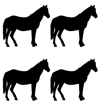
Next, select the trailer style
Do you need a cozy place to sleep?
Not Ready to Customize?
Drop us your name and email with questions and we will respond quickly

